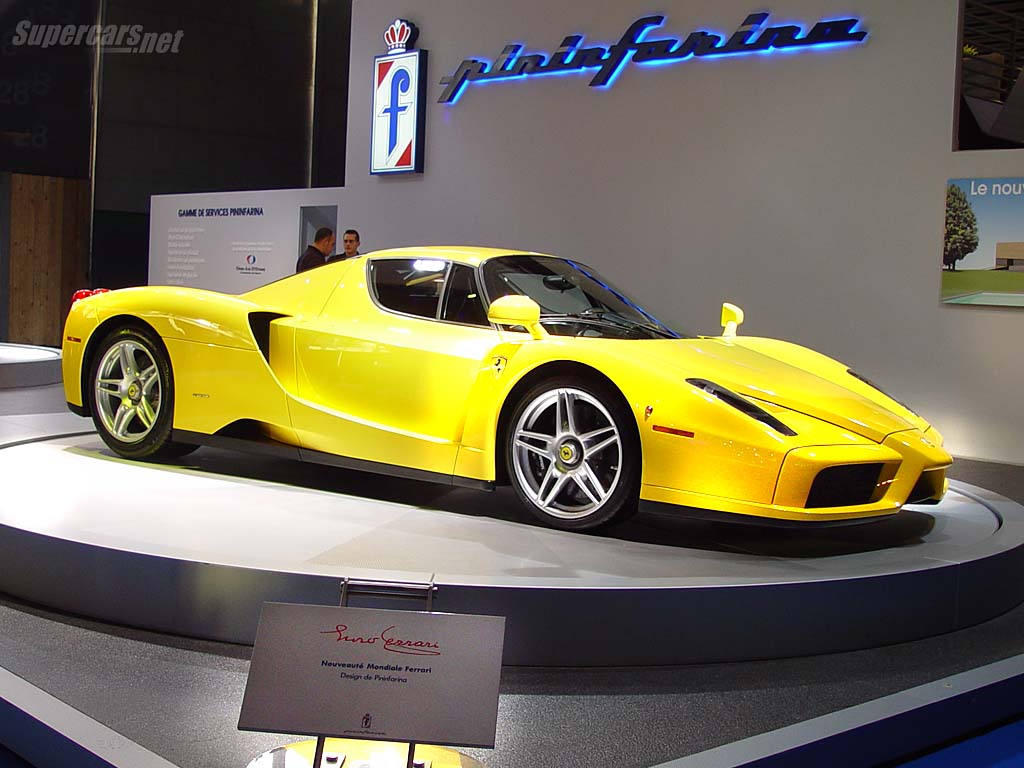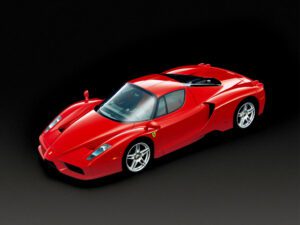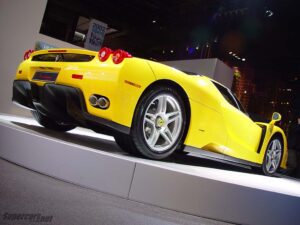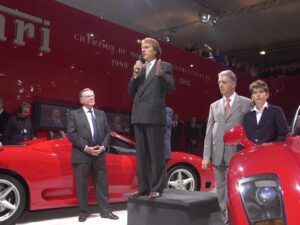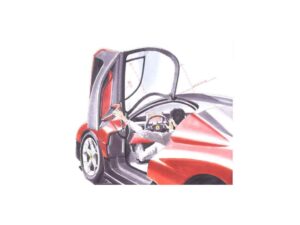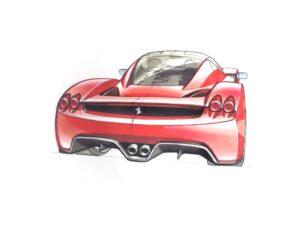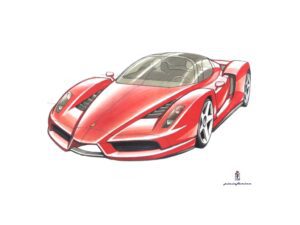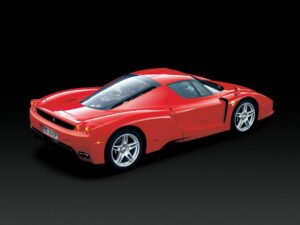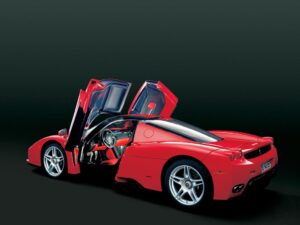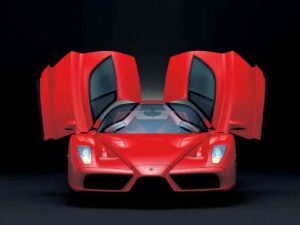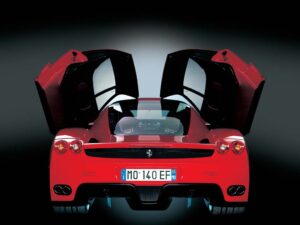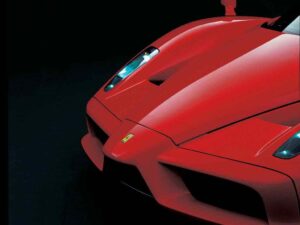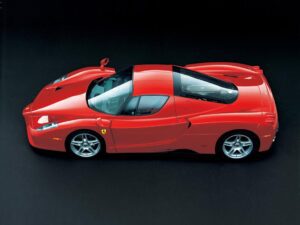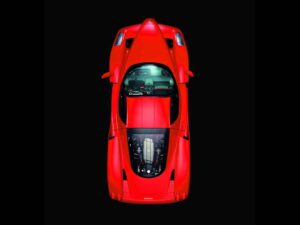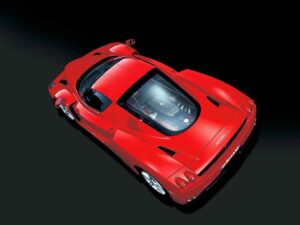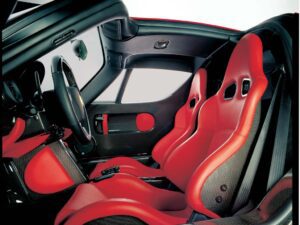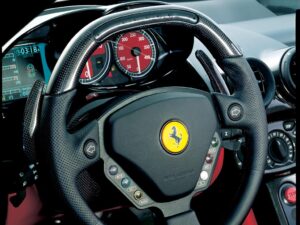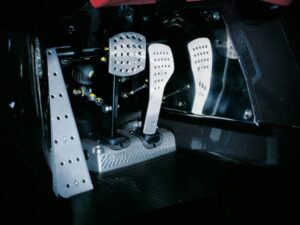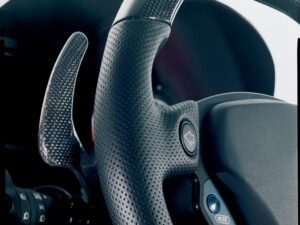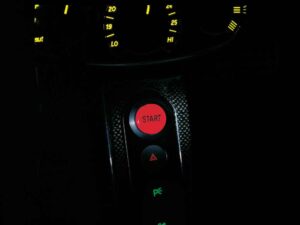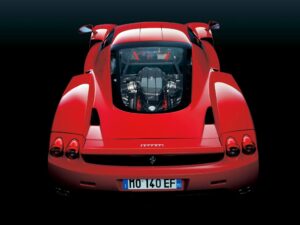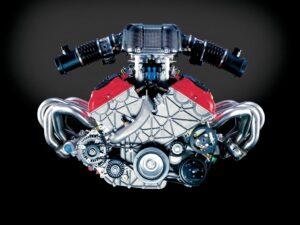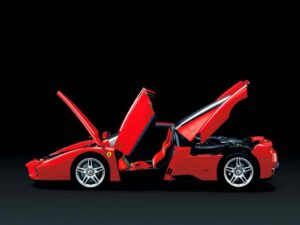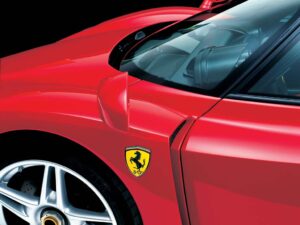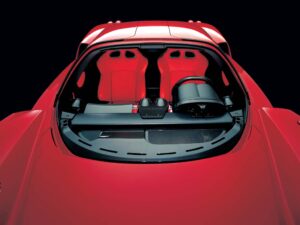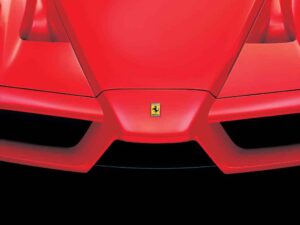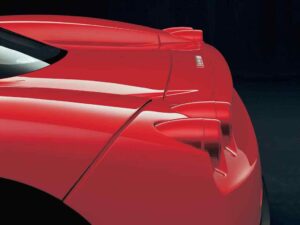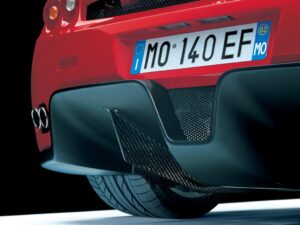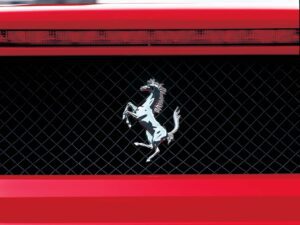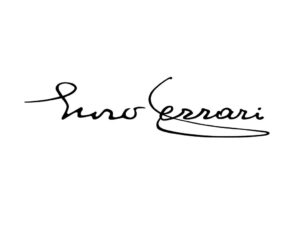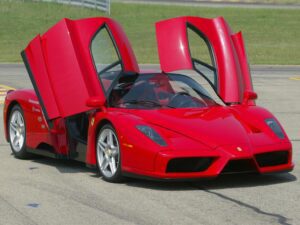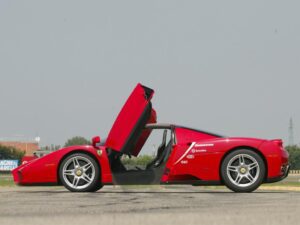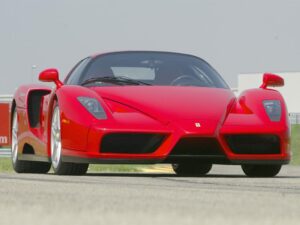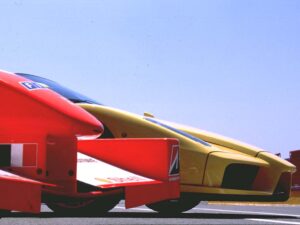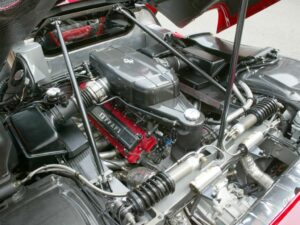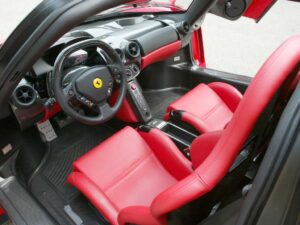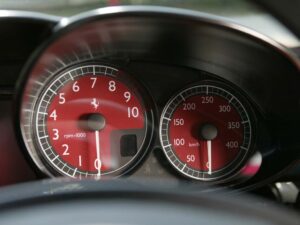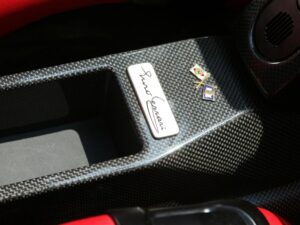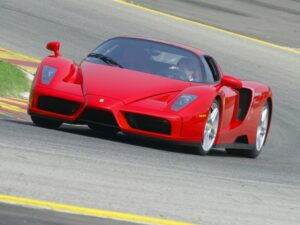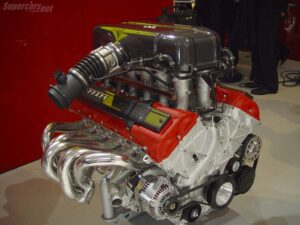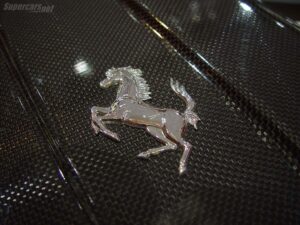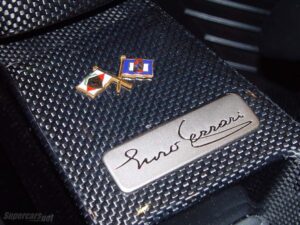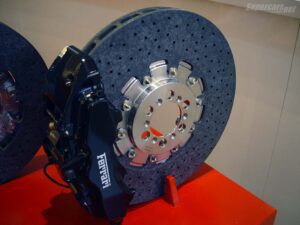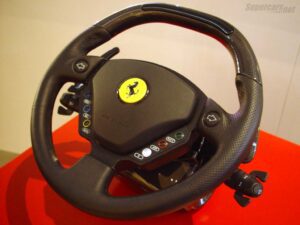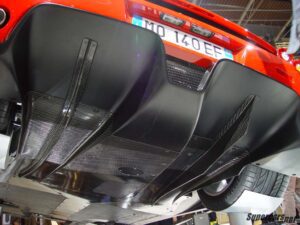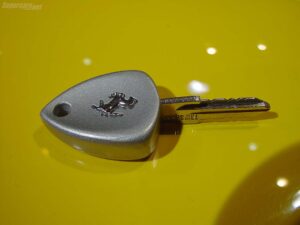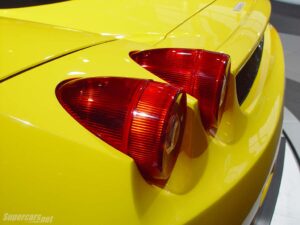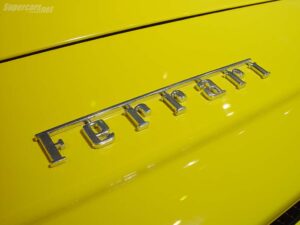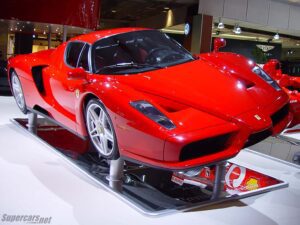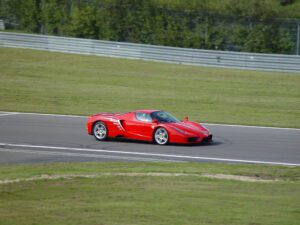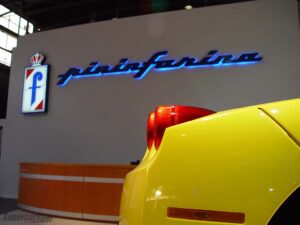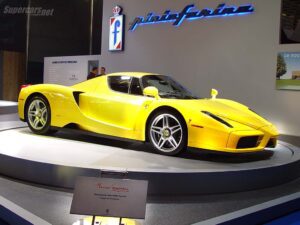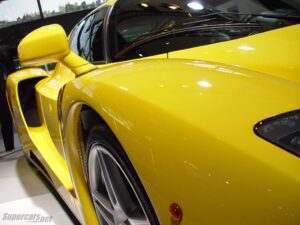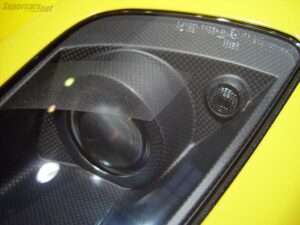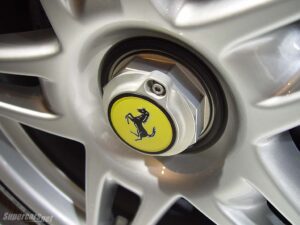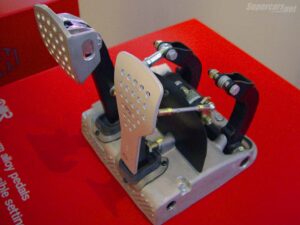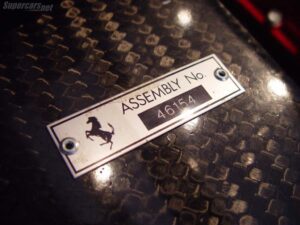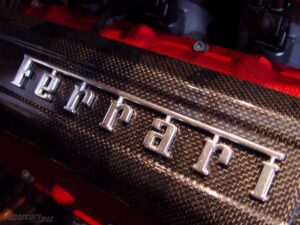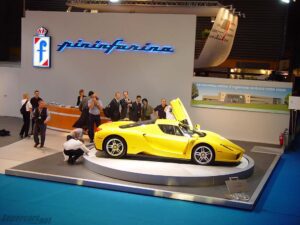2002→2005 Ferrari Enzo
Inspired by Formula One technology, Ferrari’s new Gran Turismo benefits from over fifty years of Ferrari success. Named in honor of the companies’ founder, the Enzo is one of a limited series of road cars including the 288GTO, F40 and F50. These cars represent Ferrari’s continuing desire to produce the most exclusive and technologically advanced road car.
Branding race-derived technology to road cars is not a new idea, especially to Ferrari. Up until the late fifties, Ferrari’s road and racing cars were practically the same product. Since that time, safety regulations, manufacturing costs and practicality have distinctly spilt the cars we race, from the cars we drive daily. The goal of the Enzo was to bridge this gap.
As Luca de Montezemolo states, ‘To bring together our racing success and the fundamental role of races, I decided that this car, which represents the best our technology is capable of, should be dedicated to the founder of the company, who always thought racing should lay the foundation for our road car designs.’
Built in Maranello and tested around Fiorano by both Michael Schumacher and Dario Benuzzi, the Enzo was built from a wealth of talent within Ferrari. Internally, the project was know as the FX, which cost Ferrari 20 million euros to develop.
With an initial production run of 350 Enzos, four hundred were built in either red, yellow or black, or a custom color if the customer’s relationship with the firm was strong enough. The extra fifty cars brought in $28.8 million USD (24.4 million euros) for Ferrari, with each car being sold at a $554 00 USD (487,700 EU) profit. With these figures, Ferrari has proven they not only can sell half million dollar cars, they can yield quite a profit margin from them too.
F140 V12 -One of Ferrari’s Largest
Racing-inspired technology lays the foundation of the Enzo. As such, the chassis is built from carbon fiber and aluminum honeycomb panels forming a rigid tub. At the center of the chassis is an all new, twelve-cylinder engine called the F140. At two points, the engine is attached to an alloy sub-frame which contains vibration from leaking into the passenger compartment. With this sub-frame, the Enzo is particularly unlike the F50 and unlike Formula One cars.
The F140 is one of the largest Ferrari engines, only being eclipsed by the Can Am units. Having such a large displacement allows the Enzo to deliver a healthy amount of torque, specifically 137 ft lbs (186nm) more than the F50 at 1000 rpm sooner. Despite the engine’s large displacement, it still manages to achieve 110 bhp/liter thanks to many variable systems.
Borrowed straight from Formula One developments, highlights of the F140 engine include a continuously variable intake manifold and variable valve timing. Never combined on road car before the Enzo, these systems maximize fuel consumption and torque across the range.
F1 Transmission
Attached to the engine, the transmission unit also houses an oil tank, bevel gear, differential.
An electrohydraulic system automatically activates the clutch and gear changes. This gearbox is the first semi-automatic setup on a road-going, Ferrari V12. Developments from Formula One help it achieve gear changes in 150 milliseconds and close to 90 milliseconds when in sport mode.
Four lights atop the steering wheel indicate to the driver when an up shift is needed. Gear changes are made via two paddles behind the steering wheel. No fully automatic selection is offered.
Imbedded Electronics
Designed by Ferrari Gestione Sportiva (Ferrari Sport Management), many embedded electronic systems help comfort of the Enzo driver. A central computer harmonizes the engine, suspension, transmission and aerodynamic subsystems to optimize performance and safety. How these subsystems communicate and their behaviors depend on which mode the driver selects from the steering wheel.
The Enzo has three distinct control settings which include Sport, Race and No ASR. These options primarily change the settings of the active damping, electrohydraulic shifting and traction control. In No ASR mode, the most agressive setting, the driver has the option of using Launch Control as borrowed from Formula One.
Getting much attention is the ASR which is Ferrari’s fancy term for traction control. The ASR works primarily with the ABS to guarantee a high level of stability during strong cornering forces. The ASR is so advanced that only drivers such as Benuzzi and Schumacher benefit from turning it off.
During the press preview at Fiorano all the test drives had to be done with the ASR on. This, however, did not stop 5th Gear’s Tiff Needel from promptly turning it off: ‘I can’t drive a Ferrari with that on’ promptly followed by ‘now the Ferrari is alive’ made his point well. Tiff fetched the best time of day, but remained over four seconds slower than Benuzzi.
Active Suspension
As first seen on 575, the Enzo employs a system of continuously controlled electronic dampers. This active damping allows the Enzo to offer a comfortable ride in sport mode or a hard suspension in race modes. It works by continually adjusting internal proportional valves within the dampers.
Developed in conjunction with Brembro, the braking system in the Enzo provides world-class stopping power. All four wheels sport fifteen inch, carbon-ceramic discs which are less temperature sensitive like Formula One discs which only work well when they are very hot.
The carbon-ceramic brakes mark the first time a composite disc has been applied to a Ferrari road car. The system saves 27 lbs (12.5kgs) of unsprung weight when compared to conventional steel discs. The CCM material also has the advantage of being resistant to corrosion.
Pininfarina Styling & Aerodynamics
Pininfarina and Ferrari have a close relationship which started with the 1951 212 Inter Barchetta. Since that time, Pininfarina have styled most road-going Ferraris including the Enzo, which is their most radical design to date.
Pininfarina’s form combines complex detail with a clean and balanced overall shape. Aggressive lines adorn the exterior which include an interpretation of the Formula One nose, to which the Enzo owes it’s technology. These styling cues break ground in the area of design and will be copied both in future super cars and future Ferraris.
Unlike the F40 and F50 which came before it, the Enzo is devoid of any rear wing. The absence of the rear wing was possible due to the underbody at the rear of the car which includes two large diffusers. These diffusers generate sufficient down force to replace a drag-heavy rear wing.
Further active aerodynamics help the Enzo maintain stability at all speeds. An adjustable rear spoiler and adjustable front flap allow for either high load or high speed aerodynamic setup. Above 186 mph (300kph) the Enzo reduces its down force from 1709 lbs (775kg) to 1290 lbs (585kg) allowing for a top speed of 217 mph (350 kph) .
Conclusion
During a period of great achievement for Ferrari, the Enzo reflects victories which include four consecutive F1 championships. The Pininfarina styling and semi-automatic, six-speed transmission trace their roots to heart of motor sport. No doubt, Enzo Ferrari himself would be most proud of this limited series named in his honor.
Unlike the Ferrari F50, the Enzo was made with compromises towards driver comfort. Fortunately, Ferrari have used sufficient active systems allowing level of comfort to be adjusted from the drivers seat. It is these sophisticated electronics, centered around Ferrari’s best road-worthy engine that make the Enzo as special as it is.
Story by Richard Owen
In Detail
| submitted by | Richard Owen |
| type | Series Production Car |
| production years | 2002 – 2005 |
| released at | 2002 Paris Motor Show |
| built at | Maranello, Italy |
| coachbuilder | Pininfarina |
| production | 440 |
| price $ | $ 670,000 |
| price £/td> | £450,000 |
| engine | 65 Degree, Type F140 Aluminum V12 |
| position | Mid Longitudinal |
| aspiration | Natural |
| valvetrain | DOHC, 4 Valves per Cyl w/Continuously Variable Timing |
| fuel feed | Bosch Motronic ME7 Sequential Electronic Injection |
| displacement | 5988 cc / 365.4 in³ |
| bore | 92 mm / 3.62 in |
| stroke | 75.2 mm / 2.96 in |
| compression | 11.2:1 |
| power | 492.2 kw / 660.0 bhp @ 7800 rpm |
| specific output | 110.22 bhp per litre |
| bhp/weight | 481.75 bhp per tonne |
| torque | 657.57 nm / 485 ft lbs @ 5500 rpm |
| redline | 8200 |
| body / frame | Carbon Fibre Body over Carbon Fibre Tub w/Rear Alloy Sub Frame |
| driven wheels | RWD w/TCS |
| front tires | Bridgestone Potenza RE050A Scuderia 245/35ZR19 |
| rear tires | Bridgestone Potenza RE050A Scuderia345/35ZR19 |
| front brakes | Brembro CCM (Carbon-Ceramic) Discs w/6-Pot Calipers, Power Assist ABS |
| rear brakes | Brembro CCM (Carbon-Cer?amic) Discs w/4-Pot Calipers, Power Assist, ABS |
| front wheels | F 48.3 x 22.9 cm / 19.0 x 9.0 in |
| rear wheels | R 48.3 x 33.0 cm / 19.0 x 13.0 in |
| steering | Rack & Pinion w/Power Assist |
| f suspension | Double Wishbones w/Push-Rod Actuated Coil-Shock Units, Adaptive Dampers, Electronic Shock Absorbers, Anti-Roll bar |
| r suspension | Double Wishbones w/Push-Rod Actuated Coil-Shock Units, Adaptive Dampers, Electronic Shock Absorbers, Anti-Roll bar |
| curb weight | 1370 kg / 3020 lbs |
| wheelbase | 2650 mm / 104.3 in |
| front track | 1660 mm / 65.4 in |
| rear track | 1650 mm / 65.0 in |
| length | 4702 mm / 185.1 in |
| width | 2035 mm / 80.1 in |
| height | 1147 mm / 45.2 in |
| transmission | 6-Speed Semi-Automatic w/Electrohydraulic Acuation, 215mm Twin-P |
| gear ratios | 3.15:1, 2.18:1, 1.57:1, 1.19:1, 0.94:1, 0.76:1 |
| top speed | ~350 kph / 217.5 mph |
| 0 – 60 mph | ~3.4 seconds |
| 0 – 100 mph | ~6.5 seconds |
| 0 – 1/4 mile | ~11.3 seconds |
| 0 – 100 kph | ~3.7 seconds |
| city fuel econ epa | 19.60 L/100 km or 12 mpg-us |
| hwy fuel econ epa | 13.07 L/100 km or 18 mpg-us |




